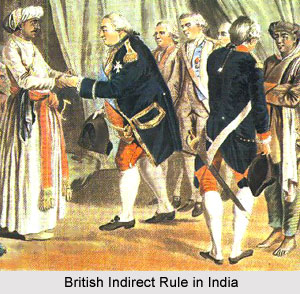 Indirect rule in British India refers to a system of government which was developed during British colonial period. In this system, most of the governance of the regions was kept in the control of the traditional Indian rulers, whom the British administration identified as Indian Princes. These rulers acquired stability and prestige, but lost their autonomy. The British Indirect rule in India allowed the European administrators to efficiently supervise the management of administrators which included a large number of people. The Princely States of India were technically autonomous regions under the British colonial rule in India. Such states were governed by an Indian Prince under a type of indirect British rule. The British administration expressed their objective of forming an imperial state during the early 19th century. The British government formulated and then continued a system of indirect rule in India which apparently created a model that was followed in several other situations of imperial administration.
Indirect rule in British India refers to a system of government which was developed during British colonial period. In this system, most of the governance of the regions was kept in the control of the traditional Indian rulers, whom the British administration identified as Indian Princes. These rulers acquired stability and prestige, but lost their autonomy. The British Indirect rule in India allowed the European administrators to efficiently supervise the management of administrators which included a large number of people. The Princely States of India were technically autonomous regions under the British colonial rule in India. Such states were governed by an Indian Prince under a type of indirect British rule. The British administration expressed their objective of forming an imperial state during the early 19th century. The British government formulated and then continued a system of indirect rule in India which apparently created a model that was followed in several other situations of imperial administration.
Indirect rule in British India was considered as the exercise of determinative and exclusive political control by the British East India Company over a nominally self-governing state. The state of indirect control was recognized by both parties and consisted of 4 vital elements-
* Both sides recognised the indirect control as effective;
* Only one unit, that is the British colonial rulers, exercised control;
* All other rivals were mostly excluded; and
* The dominant British rulers recognised some degree of dominion and control in the Princely States of India.
Several scholars and historians debate over the degree of autonomy and sovereignty of the Indian princes prior to and after they concluded treaties with the British. In several instances the British administration did not construct the Indian princes with the aim of developing them as political leaders. Although the Indian princes looked for political and material remunerations from the agreements with the British, but several of the Indian rulers were forced into subordination. Most of the Indian rulers or kings, who were later identified as princes during the 19th century, had subsisted even before the arrival of the British. Although some of the princes emerged along with the development British as regional powers. But the treaties between the Indian Princes and the British severely affected their political opportunities. Such agreements defined regional boundaries, depicting them compact and more restricted; they also regulated associations with the neighbours. It also modified relationships between a ruler and his relatives, subjects, peasants, merchant groups and administrators.
Further more, the treaties appropriated various resources of the Indian princely states, such as revenues in the form of tribute or subsidies, local people as soldiers, and different commercial goods, for the development and benefit of the British East India Company. Therefore, even if British treaties did not lead to the creation of Indian princes or princely states, these definitely shaped the prospective form and activities by setting up parameters which progressively restricted princely options. The British also implemented various political arrangements. In order to increase profits, reduce political liabilities and to limit their operational expenses, the British initially attempted to gather revenues from the administration of the Nawab of Bengal. The East India Company eventually realized that this system did not generate the profits that were required to meet its expenditures in India or in England. Thus a more direct system of revenue collection was introduced by Governor of Bengal and the first Governor-General of India Warren Hastings. Through this system British officers directly collected revenue and this concluded in the Permanent Settlement of 1793. After the zamindars were recognized as paying landlords in Bengal in the year 1793, the British administration desired to create a faithful, dependent liaison group which would supply assured revenue. But they discovered that their expanded territorial base needed to be protected from other aggressive regional powers. They soon sought new means of extending their political control.
Native states had various causes for collaborating with the British as well as other Indian states. They aimed to obtain supremacy in succession disputes in order to establish a dominant position and to gain military support during conflicts with other provincial states. The Indian rulers or princes, appealed for signs of their pre-eminence over their kinsmen from powerful external rulers.
By the year 1820, the British administration had developed a monopolistic military despotism which was funded by resources obtained from subjects in the most productive areas of the country and from other Indian commercial groups.



















